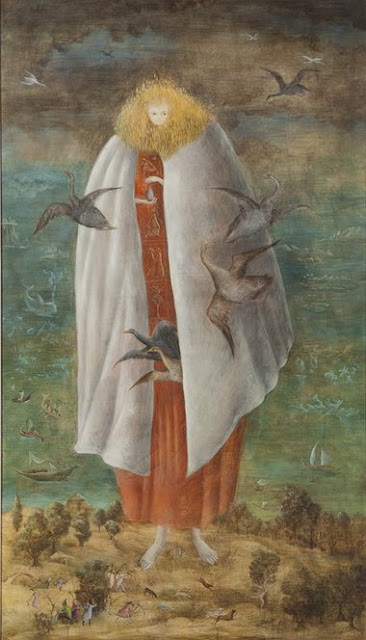Leonora developed a private visual language that she used to interpret themes of metamorphosis, magic, and whimsy.
Background: Leonora was born into a wealthy Catholic family in England, and grew up on the family estate, where she spent a lot of time riding horses.
Training: Rebellious and disobedient, Leonora was frequently expelled from school and developed an early loathing for the Church. In her late teens she was sent to a boarding school in Florence where she began painting while studying the Italian Renaissance. When Leonora returned to London, her parents permitted her to study at art academies there, and this is how she learned about Surrealism. Feeling suffocated by the rigidity and class prejudices of the English aristocracy, she was attracted to the transformative power of Surrealist aesthetics.
Private life: Leonora met Max Ernst at a party held in London in 1937. She was 20; he was 46. He was already well-connected and famous. He had been married in 1918, fathered a son, and been divorced 1922; for several years he had been part of a ménage à trois. In 1927 he married again. In 1937 he divorced this wife in order to be with Leonora. In 1938, Leonora and Max settled in a small town in southern France, where she bought a small farmhouse. They had a brief idyllic period in which they both made a lot of art. Leonora later said that Max taught her everything about art and literature.
With the outbreak of World War II, Max, who was German, was arrested, first by the French, later by the Germans. He managed to escape and flee to America with the help of Peggy Guggenheim, who was a sponsor of the arts. Max and Peggy married in New York in 1941. That marriage ended a few years later, but he and Leonora were not able to renew their relationship. In 1946, Max married another surrealist, Dorothea Tanning.
So in late 1939 and early 1940, Leonora, who was just 23 years old, found herself alone for many months in a foreign land at the outbreak of a war. She was paralyzed by anxiety and experienced delusions. Friends helped her to escape to Madrid, but there she suffered a breakdown, and in 1940 she was institutionalized by her family. She was given very intense forms of therapy, including some that have since been banned. When she was released into the care of her nanny, she escaped and sought refuge in the Mexican Embassy in Lisbon, where she knew a diplomat named Renato Luduc. He came to her aid by marrying her and taking her to New York City.
Before leaving Portugal, Leonora and Renato ran into Max and Peggy at a sidewalk cafe in Lisbon. Max suggested that since they were both in marriages of convenience, they might continue their romantic relationship, but Leonora wasn't having it. When they met the next year in New York City, Max pleaded with her, but to no avail. His casual treatment of Peggy, who had rescued him, had disillusioned Leonora.
In 1942 Leonora and Renato moved to Mexico. In 1943, when she was 26, she met Emeric Weisz, a rather famous Hungarian Jewish photographer. After getting a friendly divorce from Renato, Leonora and Emeric married. Her life calmed into stability and she was able to develop as an artist. Leonora and Emetic had two sons.
She grew close with several other Surrealist then working in Mexico. She knew Frida and Diego, and attended their second wedding.
Career: Leonora devoted herself to her artwork in the 1940s and 1950s, developing an intensely personal Surrealist sensibility that combined autobiographic and occult symbolic.
In her art, her dreamlike, often highly detailed compositions of fantastical creatures in otherworldly settings are based on an intensely personal symbolism. Themes of metamorphosis and magic, as well as frequent whimsy, have given her art an enduring appeal.
Throughout a seven-decade career of prolific creation, the same images have appeared in Carrington's art again and again. Ghosts turn into crows, pigs unfurl wings, armchairs produce arms and women grow birds as limbs.
Leonora's work touches on ideas of sexual identity yet avoids the frequent Surrealist stereotyping of women as objects of male desire. Instead, she drew on her life and friendships to represent women's self-perceptions, the bonds between women of all ages, and female figures within male-dominated environments and histories.
Leonora was honored with her first one-woman exhibition in New York in 1947. She became a celebrity almost overnight. This was followed by solo and group shows around the world throughout the 20th century, and her work has received even more attention in the 21st century.
Most of her paintings are in private collections, which makes seeing them rare.
Leonora was a prolific writer as well as a painter, publishing many articles and short stories, and one highly regarded novel, The Hearing Trumpet, 1976.
She died in Mexico City in 2011 of complications due to pneumonia. She was 94 years old.
My photos of Leonora's work:
 |
| Nunscape at Manzanillo, 1954 Dallas / Jan's photo |
 |
| Dear Diary--Never Since We Left Prague, 1955 Minneapolis / Jan's photo |
 |
| Dos Personajes, 1965 Crocker / Jan's photo |
Internet Examples:
 |
| Self-portrait, c. 1938 Metropolitan Museum of Art / Internet |
 |
| Portrait of Max Ernst, 1939 Internet |
 |
| The Giantess, c. 1947 Internet |
 |
| Evening Conference, 1949 Internet |
 |
| The Lovers, 1987 Wikiart |

